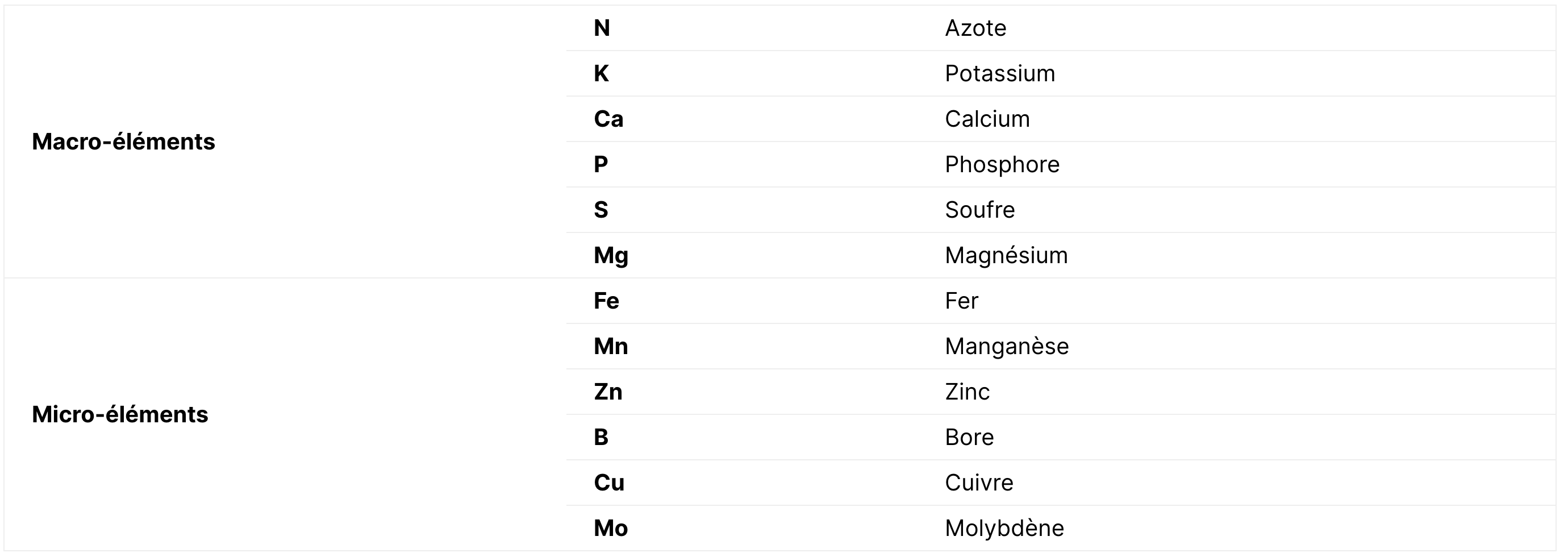
Light and fertilization: what is their relationship?
Proper fertilization to optimize photosynthesis.
14 November 2023
Fertilization provides the various minerals required for a plant’s growth. A nutritional imbalance can modify and limit certain processes essential to crop development, in particular photosynthesis.
Photosynthesis comprises two phases. A photochemical phase which converts light energy into chemical energy in the form of ATP* and reducing potential. The second phase consists of a chemical phase in which the Calvin cycle uses this energy to fix carbon for the creation of organic matter.
The photochemical phase is initiated by the absorption of light by chlorophyll. However, nutritional deficiencies, particularly in N, Fe and Mg, lead to a reduction in chlorophyll concentration, thus reducing photosynthesis.
Cu, Mn, N and P are necessary for the reactions that produce ATP. A phosphorus deficiency will inhibit ATP-synthase activity and thus reduces plant’s productivity.
Depending on the intensity received and the plant’s stages of development, chlorophyll and ATP requirements change. Appropriate fertilization is therefore essential to avoid limiting photosynthesis.
Mineral requirements impacted by spectral quality.
Nutrients uptake by plants can be modified by light or more specifically, by the quality of the light spectrum. Indeed, Pinho et al. 2016 showed that adding far-red to red and blue LED lights increased the uptake of macro-nutrients such as K, Ca and Mg in lettuce. Similarly, Fe and Zn uptake was increased by switching from a light to a darker red.
The red/blue color ratio also influences nutrient uptake. Again on lettuce, Chen et al. 2014 showed that a spectrum with 30% blue and 80% red light induced the greatest absorption of the following mineral elements: Ca, Mg, Na, Fe, Mn, Zn and B in lettuce. Pennisi et al. 2019 also found an effect of the red/blue color ratio on mineral absorption, with greater absorption of N, P, K and Mg with a red/blue ratio equal to 3.
These experiments have shown that, at equal intensity, mineral uptake differs according to the spectrum deployed. The quality of the light spectrum can influence mineral nutrition via related physiological processes such as carbohydrate translocation, transpiration and stomatal control or growth (Pennisi et al. 2019; Tramblay et al. 1988).
Appropriate fertilization for a successful crop.
Light plays a key role in optimizing and controlling production factors. Total control of the light spectrum, in terms of both quantity and quality, opens up new possibilities for optimizing the absorption of micro and macro nutrients. Consequently, depending on the light spectrum, specific fertilizations can be implemented to keep plants free from nutritional disorders.

Abbreviations
ATP: Adenosine Triphosphate
Table 1: Abbreviations and full names of macro- and microelements
Bibliography
Chen, X.-L., Guo, W.-Z., Xue, X.-Z., and Mmanake Beauty, M. 2014. Effects of LED spectra combinations on mineral element absorption of hydroponic lettuce. Guang Pu Xue Yu Guang Pu Fen Xi 34(5): 1394-1397.
Pennisi, G., Orsini, F., Blasioli, S., Cellini, A., Crepaldi, A., Braschi, I., Spinelli, F., Nicola, S., Fernandez, J.A., Stanghellini, C., Gianquinto, G. and Marcelis, L.F.M. 2019. Resource use efficiency of indoor lettuce ( Lactuca sativa L.) cultivation affected by the red:blue ratio provided by LED lighting. Scientific Reports 9(1): 1-11.
Pinho, P., Jokinen, K. and Halonen, L. 2017. The influence of LED light spectrum on growth and nutrient uptake of hydroponically grown lettuce. Lighting Research and Technology 49(7)
Tremblay, N., Gasia, M.C., Gerauge, M.T., Gosselin, A. and Trudel, M.J. 1988. Effects of spectral quality of light on nutrient uptake by tomato. Can. J. Plant Sci. 68(1): 287-289


